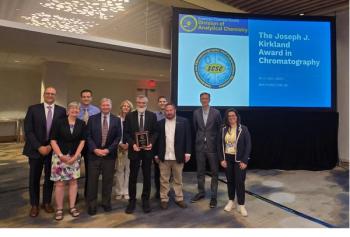
Metallic Ions Observed and Analyzed Using Single Drop Microextraction
Scientists from Ames National Laboratory in Ames, Iowa recently analyzed silver(I) and copper(I) ions to understand the environmental factors when they are altered.
Scientists from Ames National Laboratory in Ames, Iowa recently analyzed silver(I) and copper(I) ions to understand the environmental factors when they are altered. Their work was published in the Journal of Separation Science (1).
Silver(I) and copper(I) ions have electronic configurations that enable complexation with electron-rich compounds such as olefins and aromatics. Whenever electrons from a molecular π-orbital are donated to a s orbital of a metal(I) ion, a σ-bond is formed. From there, electrons from the atomic d orbital of the metal element are donated to the compound’s π-orbital, creating a second π-bond. This reversible complexation combined with π-selectivity has led to silver(I) and copper(I) ions being used as separation media in several separation systems. To better understand this process, the scientists opted to experiment on these metal ions using techniques involving small volumes of ionic liquids (ILs), which are solvents known for low melting points, low vapor pressure, and their chemical structure tunability.
The technique used in this procedure was headspace single drop microextraction (HS-SDME), which involves a solvent microdroplet being exposed to a sample solution’s headspace to extract volatile analytes. The technique, which has been used in environmental, food, and pharmaceutical analysis, is notable for being simple to employ and being compatible with techniques such as high-performance liquid chromatography (HPLC) and gas chromatography (GC). Using HS-SDME and HPLC, silver(I) and copper(I) bis[(trifluoromethyl)sulfonyl]imide salts were dissolved in a 1-decyl-3-methylimidazolium bis[(trifluoromethyl)sulfonyl]imide ionic liquid, where they were studied as the mixture was used as extraction media for aromatic compounds.
While water and acetonitrile within the sample solution seemed to interfere with the complexation of the ions and aromatic compounds, ethylene glycol and triethylene glycol did not. Furthermore, other experimental factors were affected, including sample solution composition, temperature, and extraction time. The HS-SDME experiments were conducted at temperatures ranging from 25°C to 45°C, with the concentration of aromatic analytes extracted by IL microdroplets increasing until 40°C was reached. Once 45°C was reached, variation of the analyte extraction efficiencies arose based on functional groups and the amount of silver(I) ion in a microdroplet. Additionally, partition coefficients between the sample headspace and metal ion were determined, and though there were no observable differences in analyte partitioning, the analyte partition coefficients to silver(I) ions were greater than those of copper(I) ions.
The study showed HS-SDME’s potential in studying molecular complexation between metal ions and aromatic compounds in ILs, in addition to its applicability in investigating the effects of solvents and analyte equilibration.
Reference
(1) Eor, P.; Byington, M.; Anderson, J. L. Comparing π-complexation capabilities of ionic liquids containing silver(I) and copper(I) ions by headspace single drop microextraction in combination with high-performance liquid chromatography. J. Sep. Sci. 2023, 2300649. DOI:
Newsletter
Join the global community of analytical scientists who trust LCGC for insights on the latest techniques, trends, and expert solutions in chromatography.





